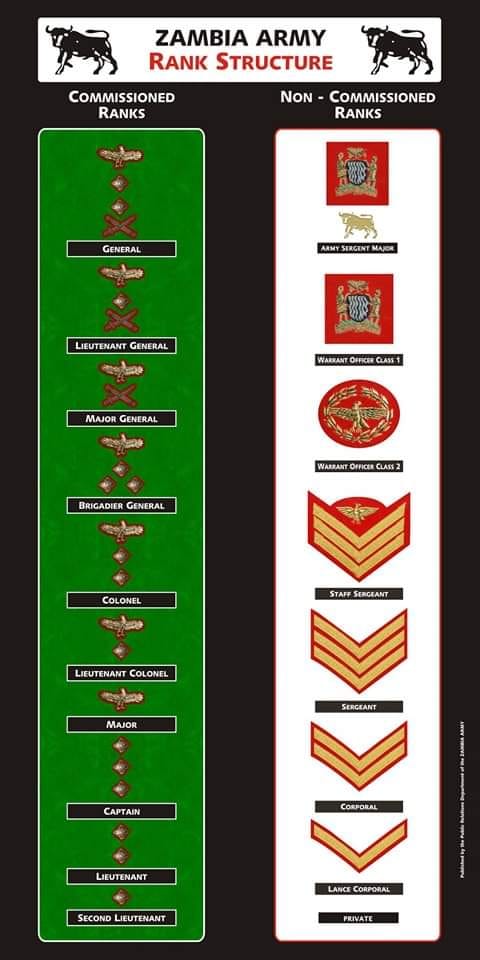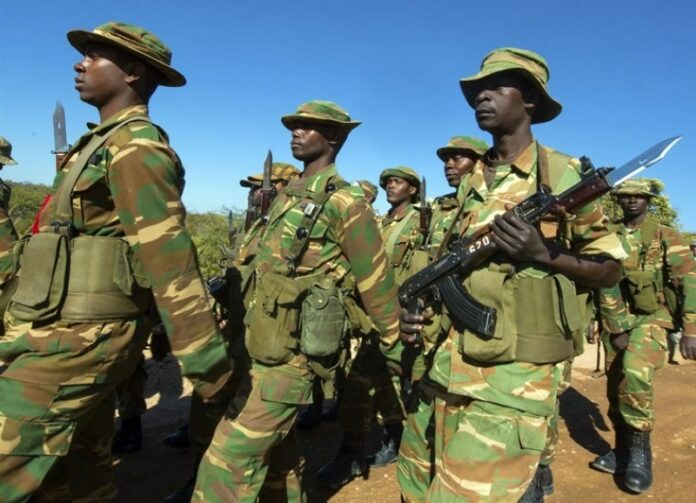UNDERSTANDING MILITARY RANKS
By Hamwiinde Munamunungu
Lusaka
Our community needs to have a working knowledge of the ranks of our defence forces in Zambia, including the command structures, by rank.
It is also important to divide the ranks into two distinct groups (noncommissioned and commissioned officers) for better understanding.
In the Army, promotions of Commissioned Officers, whose ranks start with Second Lieutenant, are a preserve of the President, while Non- Commissioned Officers, whose ranks range from corporal to Warrant Officer Class I, are promoted by the Commander through the
authority of the President in a government gazette.
NON-COMMISSIONED OFFICERS
The first structure concerns what is generally known as Other Ranks or Non-Commissioned officers.
In general terms, this includes one from the recruit category, signifying one who is under basic military training.
Upon completion of training, one becomes a Private soldier.
Upon satisfactory completion of about eighteen months, one may qualify for subsequent promotion to Lance Corporal, then move to Corporal, Sergeant, Staff or Colour Sergeant, to Warrant Officer Class II, and finally to Warrant Officer Class I.
This group is pyramidal in structure. More private soldiers and corporals at the base, and then reducing progressively to Sergeant, Staff Sergeant, Warrant Officer Class 11, and finally very few Warrant Officers Class I.
It is possible to have only one warrant officer class one in a battalion.
The breakdown of other ranks is as follows:
Private: Soldiers in this rank make up the bulk of the population.
Lance Corporal: Sizeable Sergeant: A couple of them Staff sergeants: Soldiers in this rank are getting fewer.
Warrant Officer Class II: This rank focuses on the
instruction, discipline, welfare, and order of a company in a battalion.
Warrant Officer Class I: Very few or limited in number. This is the highest rank amongst non- commissioned officers, also known as Other Ranks, and only this group qualifies to be called Mr or Mister in the Army.
Army Sergeant Major: The Army Sergeant Major of the Army (ASM) is a unique non-commissioned rank and position of office in Zambia Army, it is held by just one soldier. The holder of this rank and position is the most senior enlisted soldier in the Zambia Army.
These ranks were historically reserved for the Army but were later introduced by President Kenneth Kaunda for general use in Zambia Air Force (ZAF) and Zambia National Service in Zambia.
Otherwise, ZAF has had its traditional ranks drawn from the British Royal Air Force.
Equally, the Zambia National Service had created its equivalent ranks, which have been merged with the army ranks.
COMMISSIONED OFFICERS
The second category is that of the officer ranks, or officer corps. These are also pyramidal in structure.
Broad at the base and thin out as you go upwards.
The order goes as follows:
Officer Cadet: This is a rank held by military cadets during their training to become commissioned officers.
Second Lieutenant: This is the typical commissioning rank following training.
Lieutenant: This rank is bestowed to others upon
promotion or commissioning. It ranks above second lieutenant but below captain.
Captain: The army rank of Captain is a commissioned officer rank that historically
corresponded to command of a company of soldiers. It is also a promotion and commissioning rank, especially for medical doctors, lawyers, and some chaplains.
Major: This is a military rank of commissioned officers, having similar ranks in numerous armed services around the world. It is one rank above captain and one rank lower than lieutenant colonel. It is considered the most junior of the field officer levels.
Lieutenant Colonel: Lieutenant Colonel is a commissioned officer rank in the Zambia Defence Force that is awarded upon promotion.
Colonel: This is a senior military officer rank received as a promotion rank.
Full Colonels and above are known as Members of the General Staff of the Army, or ZAF or ZNS.
As such, a full colonel may be assigned or appointed to a senior command position.
For instance, Honourable Kingsley Chinkuli took
command of the army as a full colonel.
Brigadier General: This is the last rank received on promotion in the Zambia Defence Force. The rank is above a colonel, and below a major general or divisional general.
When appointed to a field command, a brigadier general is typically in command of a brigade consisting of around 4,000 troops.
Major General: Rank received by promotion.
Lieutenant General: Received by promotion.
General: A General of the Army, like a Field Marshal, is a 5-star general.
General, Lieutenant General, Major General, and Brigadier General are the first-, second-, third-, and fourth-grade officers of the General Staff in the British Army and other world armies.
The rank of general or full general is rarely provided for in our Army because of its size.
However, for political expediency, President Kaunda created the position of general and promoted Hon Chinkuli when the Zambia National Defence Force (ZNDF) was created, and Honourable Malimba Masheke as full generals. Once again, President Frederick Chiluba promoted Nobby Simbeye to full general, while General Isaac Chisuzi was promoted by President Levy Patrick Mwanawasa.
Field Marshal: is ranked immediately above General but not exercised in the regular army structure. It is largely a ceremonial or wartime rank, having been awarded only twice.
A Field Marshal’s insignia consists of the national emblem over a crossed baton and the sabre in a lotus blossom wreath.
Field Marshal is a great honour and is rarely used nowadays in many world armies.
Jean- Bedel Bokassa of the Central African Republic, Idi Amin of Uganda, Samora Machel of Mozambique, and FM Mobutu of the Democratic Republic of the Congo were among Africa’s Field Marshalls.
Here is the structural command structure:
Army Units: A company consists of three or four platoons and is generally commanded by a captain.
It can also go by different names, depending on the function: Company- sized artillery units are called batteries, while in armour and air cavalry units, they are called squadrons .
Platoon: About 36 men or women, commanded by a subaltern (a Lieutenant or Second Lieutenant)
Company: About 150 men and women, commanded by a Major, with a Captain as Second in Command Battalion: 750–800 men and women, commanded by a Lieutenant Colonel
Brigade: Two or three battalions, commanded by a Brigadier General
Division: Two (usually three) brigades, commanded by a Major-General.
Corp: Three divisions, commanded by a Lieutenant General.
Army: Three or four divisions, commanded by a general.
It is worth noting that all ranks in the three defence wings are uniform.
Author is a retired colonel in the Zambia Army.

